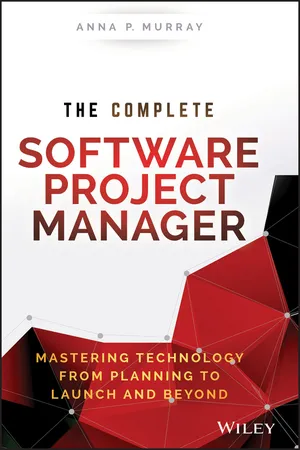
The Complete Software Project Manager
Mastering Technology from Planning to Launch and Beyond
- English
- ePUB (mobile friendly)
- Available on iOS & Android
The Complete Software Project Manager
Mastering Technology from Planning to Launch and Beyond
About this book
Your answer to the software project management gap
The Complete Software Project Manager: From Planning to Launch and Beyond addresses an interesting problem experienced by today's project managers: they are often leading software projects, but have no background in technology. To close this gap in experience and help you improve your software project management skills, this essential text covers key topics, including: how to understand software development and why it is so difficult, how to plan a project, choose technology platforms, and develop project specifications, how to staff a project, how to develop a budget, test software development progress, and troubleshoot problems, and what to do when it all goes wrong. Real-life examples, hints, and management tools help you apply these new ideas, and lists of red flags, danger signals, and things to avoid at all costs assist in keeping your project on track.
Companies have, due to the nature of the competitive environment, been somewhat forced to adopt new technologies. Oftentimes, the professionals leading the development of these technologies do not have any experience in the tech field—and this can cause problems. To improve efficiency and effectiveness, this groundbreaking book offers guidance to professionals who need a crash course in software project management.
- Review the basics of software project management, and dig into the more complicated topics that guide you in developing an effective management approach
- Avoid common pitfalls by perusing red flags, danger signals, and things to avoid at all costs
- Leverage practical roadmaps, charts, and step-by-step processes
- Explore real-world examples to see effective software project management in action
The Complete Software Project Manager: From Planning to Launch and Beyond is a fundamental resource for professionals who are leading software projects but do not have a background in technology.
Frequently asked questions
- Essential is ideal for learners and professionals who enjoy exploring a wide range of subjects. Access the Essential Library with 800,000+ trusted titles and best-sellers across business, personal growth, and the humanities. Includes unlimited reading time and Standard Read Aloud voice.
- Complete: Perfect for advanced learners and researchers needing full, unrestricted access. Unlock 1.4M+ books across hundreds of subjects, including academic and specialized titles. The Complete Plan also includes advanced features like Premium Read Aloud and Research Assistant.
Please note we cannot support devices running on iOS 13 and Android 7 or earlier. Learn more about using the app.
Information
Chapter 1
Software Development Explained: Creativity Meets Complexity
A Definition of Software Development
- Launching websites
- Installing a CRM (customer relationship management) tool
- Implementing a new accounting package
- Building a custom application for your business
Why Is Software Development So Difficult? Hint: It's Not Like Building a House
- Writing a novel
- Growing a garden
- Composing a symphony
The Simple, the Complicated, and the Complex
- Simple project components are easy to conceptualize. You know what needs to get done, and you simply need to get out the elbow grease and do it.
- Complicated project components are hard to understand and involve a lot of steps, but they are not very risky. If you read the directions carefully enough and follow them, you will get the project done.
- Complex pieces of projects, on the other hand, have a lot of variables like the complicated, but they are also highly fluid and very risky.
Metaphor #1: Piles of Snow

Metaphor #2: The Ikea Desk

Table of contents
- Cover
- Title Page
- Copyright
- Table of Contents
- Dedication
- Foreword
- Acknowledgments
- About the Author
- Introduction
- Chapter 1: Software Development Explained: Creativity Meets Complexity
- Chapter 2: Agile, Waterfall, and the Key to Modern Project Management
- Chapter 3: Project Approaches; Off-the-Shelf and Custom Development; One Comprehensive Tool and Specialized Tools; Phased Launches and Pilots
- Chapter 4: Teams and Team Roles and Responsibilities Defined
- Chapter 5: Project Research and Technology Choice; Conflicts at the Start of Projects; Four Additional Project Delays; Initial Pitfalls
- Chapter 6: Final Discovery; Project Definition, Scope, and Documentation
- Chapter 7: Budgeting: The Budgeting Methods; Comparative, Bottom-Up, Top-Down, and Blends; Accurate Estimating
- Chapter 8: Project Risks: The Five Most Common Project Hazards and What to Do About Them; Budgeting and Risk
- Chapter 9: Communication; Project Communication Strategy; from Project Kickoff to Daily Meetings
- Chapter 10: The Project Execution Phase: Diagnosing Project Health; Scope Compromises
- Chapter 11: First Deliverables: Testing, QA, and Project Health Continued
- Chapter 12: Problems: Identifying and Troubleshooting the Three Most Serious Project Problems; Criteria for Cancellation
- Chapter 13: Launch and Post-Launch: UAT, Security Testing, Performance Testing, Go Live, Rollback Criteria, and Support Mode
- Project Tools
- Glossary
- Index
- End User License Agreement